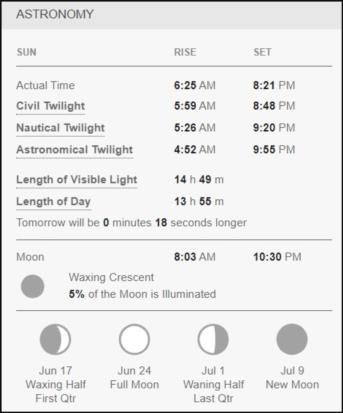
NavList:
A Community Devoted to the Preservation and Practice of Celestial Navigation and Other Methods of Traditional Wayfinding
From: Frank Reed
Date: 2021 Jun 12, 20:15 -0700
Matus Tejiscak, you wrote:
"I tried to guess where you are. I started by assuming the US."
Aha! That's an interesting puzzle to solve from the available information. The result that you found "Albany NY" is a bit far off, but I thought you might like a little more data from that weather website (I had clipped off the full details last time). The image here is for today, 12 June 2021, but a different location. I do believe that the numbers listed here are correct for the chosen location within one minute of time (maybe they round up/down or truncate seconds ...I don't have conclusive evidence either way). But given that assumed level of accuracy in the numbers, can you determine the observer's approximate latitude and longitude, and with what error bars?
I switched the location because many people following NavList messages know where I live, and you could figure it out from just a little poking around in my recent messages, too. So this makes it much more challenging and other folks can play along, too.
By the way, I'm appalled (appalled!) by the symbology that this website uses for the phases of the Moon. :)
We can get back to this business of different ways to define a day another time, but a couple come to mind right now. First there's the LAN-to-LAN day. Geoffrey Kolbe's neat prism experiment can capture the instant of local meridian passage to about a second, so we could time how long it is from one local noon to the next. It will only rarely be exactly 24 hours. The second definition that comes to mind is the true rotation period of the Earth relative to the "fixed stars" (or the cosmological rest frame, or similar). That's close to but not identical to the sidereal day. Does it have an established name??
Frank Reed







